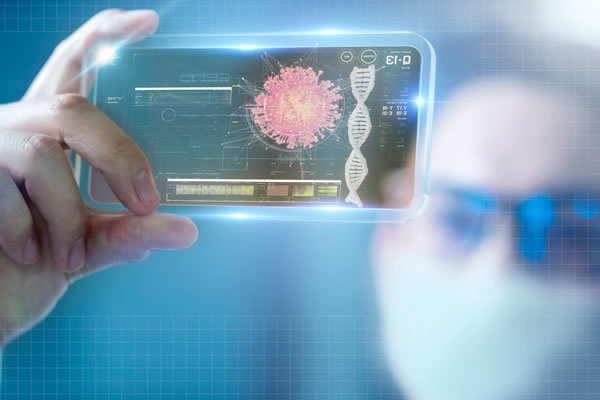How a Pandemic is Accelerating Technology Breakthroughs
The Silver Lining
The coronavirus pandemic may still be plowing its way through the country, leading to business closures, shut downs and social distance rules, but it’s also been the harbinger of technology breakthroughs as people shift the way they function. From AI to remote work tools to workforce shifts, this pandemic is breaking through technology barriers at a break-neck speed. That old proverb has never been truer: “Necessity is the mother of invention.” Translation: the driving force for most new inventions is need. In a time when people were forced into a new normal in a matter of days or weeks, the demand for change brought about some pretty cool technology breakthroughs.
As businesses shuttered and sent their employees home, a new way of thinking was needed — FAST. Born from this pandemic came an innovation spurred on by tragedy. The technology race has always been there, but its progress has been somewhat slow, until now. Indeed, this accelerated change has restructured workplaces, redefined roles, and instituted rapid learning, all while organizations were being challenged — and still are — to embrace a new way of thinking. The rush to virtualize business operations continues as social distance directives have taken the top spot on the best practice list.
Coronavirus as an Accelerant
Who would have predicted that COVID-19 would be the catalyst for such business transformation just a few months ago? As companies are forced to adapt to the future of work at an accelerated pace, they’re increasingly embracing culture and purpose as they pivot team operations to enable remote working on a grand scale, says Forbes. Fueled by coronavirus, technologies are making breakthroughs at a rapid pace, in a variety of ways — not just in the virtual conference room.
• Online Meetings: As employees vacated their corporate campuses and set up shop at home, they turned to online meeting platforms such as Zoom, Slack, Skype and Google Hangouts to meet up, collaborate, and get work done. After all, the show must go on. This was one of the biggest technology breakthroughs.
• Virtual events: It’s not just business meetings that are taking place virtually, it’s events, too — coordinators of which have never faced such a big challenge before. But they’re bringing it all together and it’s working. For instance, Mobile World Congress held a one-day digital event, Google Cloud Next became Google Cloud Next ’20: Digital Connect, Facebook F8 is all-online, Starbucks is even holding its shareholder meeting completely online for the first time ever, and colleges the country over are holding virtual orientation sessions for incoming freshmen.
• Technology breakthroughs in Schools: Google Classroom and Zoom have been a godsend for education nationwide. With schools being forced to close their doors in March, that’s four months of learning that would have been wasted had these online platforms not been available. Teachers had to learn in a pinch how to adjust their curricula and hold virtual classrooms, while students had to adjust to a new way of learning and communicating.
• Healthcare: Networks of epidemiologists are tracking COVID-19 using low-cost gene-sequencing technologies, which are coincidentally driving promising vaccine candidates. Researchers are using machine learning to search through repositories of published scholarly articles about coronavirus. Informal networks of manufacturing firms and hobbyists are utilizing 3D printers to make thousands of face shields to protect front-line healthcare workers. Apple and Google — in an unprecedented move — partnered together to develop a contact tracing application that is embedded in the operating systems for smartphones, according to Newswise. On a related note, Apple’s latest iPhone update, iOS 13.5, will make it easier to wear a face mask and use Face ID to open your phone.
• Network and mobile communications have enabled online medical consultations to prevent the need for in-office visits, giving first responders high-speed telecommunications to provide support where it’s needed most, and disseminating vital information around the world to enable local governments so they can make more informed decisions related to the health of constituents. Perhaps most pervasively has been the way these communications advancements have transformed social connectivity with family and friends in lieu of gathering together physically, through online videos, social media and FaceTime. Technology breakthroughs are showing much promise in this area.
• Artificial intelligence, automation, virtual reality and data management technologies have all played an important role in anything from tracking the outbreak and planning out scenarios to rapidly building medical devices and supporting research in coming up with viable treatments. In fact, artificial intelligence and genetic applied science are making it faster, easier and more affordable to understand how the virus spreads, how it should be managed and how its effects can be contained. AI can even warn us of upcoming epidemics so we have enough time to prepare. As one example, BlueDot — a global artificial intelligence database company, — uses A.I.-powered algorithms, natural-language processing and machine learning to analyze information from a variety of sources and track more than 100 infectious diseases.
Final thoughts
Perhaps the silver lining from the pandemic is the emerging technology breakthroughs that allows us all to stay in touch, make advancements, and ensure the world spins on. Organizations from all sectors are crafting new technical capabilities, harnessing digital technologies and evolving their business models at a pace that would have been unheard of just a few months ago.

